
Canyet is a district of Badalona that occupies the northern end of the municipality. [1]

Canyet is a district of Badalona that occupies the northern end of the municipality. [1]
The current limits approved by the Town Hall in 1980 are: riera de Canyet turning westwards by the road from Can Mora to the municipal term of Santa Coloma de Gramanet, limit of this term and that of Montcada y Reixac, limit with San Fausto de Campcentellas, Riera de Pomar, Turó d'en Boscà y Calle Ferrater.

The neighborhood is formed by a group of isolated typical farms and a more modern nuclei formed from constructions for vacationers. These summer resorts began in the 1920s and ended up becoming the first residences. [1]
The good conservation of the farms is the reason that 12 of them are included in the special Plan of protection of the historical heritage of Badalona. They are the farmhouses of the Torre Codina, Can Trons, Can Miravitges, Can Ferrater, Ca l'Arquer, Mas Boscà, Can Butinyà, Can Mora, Mas Amigó, Mas Oliver and Cal Dimoni. One of these houses is deemed of particular significance, Can Pujol. [2]
Among the summer resorts converted into first residences are: the colony of Sant Antoni, in the surroundings of can Campmany; the Sant Jaume colony, in the surroundings of the Mas Oliver and the Sant Jordi colony, in the surroundings of the Codina Tower.
The most important monument of the neighborhood is the Monastery of San Jerónimo de la Murtra. [1]
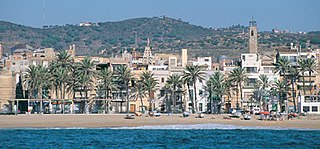
Badalona is a municipality in Barcelonès county, in Catalonia (Spain). It is located to the north east of Barcelona, on the left bank of the Besòs River and on the Mediterranean Sea, in the Barcelona metropolitan area. By population, it is the third largest city in Catalonia and the twenty-third in Spain. It became a city in 1897.
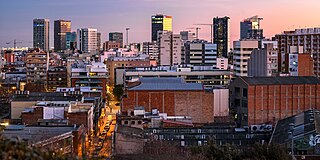
L'Hospitalet de Llobregat, often shortened to L'Hospitalet or just L'H, is a municipality in the Barcelonès comarca, in Catalonia (Spain). It is part of the Barcelona metropolitan area, the Barcelona province, and of the Barcelona conurbation.
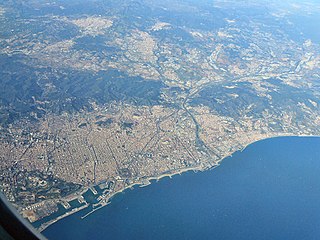
Barcelona is a province of eastern Spain, in the center of the autonomous community of Catalonia. The province is bordered by the provinces of Tarragona, Lleida, and Girona, and by the Mediterranean Sea. Its area is 7,726 km2 (2,983 sq mi). A total of 5,743,402 people live in the province, of whom about 29% (1,664,182) live within the administrative limits of the city of Barcelona, which itself is contained in the Barcelona metropolitan area.

The Democratic Convergence of Catalonia, frequently shortened as Convergence was a Catalan nationalist, liberal political party in Catalonia (Spain), currently still existing without any political activity.

The Costa Brava is a coastal region of Catalonia in northeastern Spain. Sources differ on the exact definition of the Costa Brava. Usually it can be regarded as stretching from the town of Blanes, 60 km (37 mi) northeast of Barcelona, to the French border – in other words it consists of the coast of the province of Girona.

Sant Andreu de Llavaneres is a municipality located 36 km north of Barcelona (Catalonia) (Spain), along the Mediterranean coast, between Mataró and Sant Vicenç de Montalt. It belongs to the Maresme comarca and the Barcelona province. The short name is simply Llavaneres.

Francisco Mora y Borrell was a Spanish-born prelate of the Catholic Church. He was the third Bishop of Monterey-Los Angeles, serving from 1878 to 1896.

Passeig de Lluís Companys is a promenade in the Ciutat Vella and Eixample districts of Barcelona, Catalonia, Spain, and can be seen as an extension of Passeig de Sant Joan. It was named after President Lluís Companys, who was executed in 1940. It starts in Arc de Triomf and ends in Parc de la Ciutadella, on Carrer de Pujades.
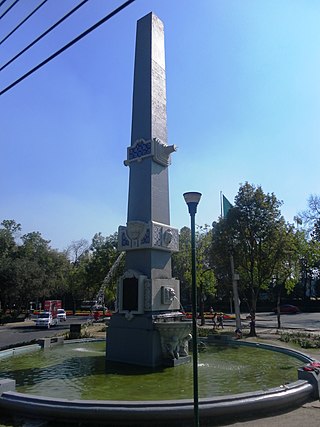
Polanco is a neighborhood in the Miguel Hidalgo borough of Mexico City. Polanco is an affluent colonia, noted for its luxury shopping along Presidente Masaryk Avenue, the most expensive street in Mexico, as well as for the numerous prominent cultural institutions located within the neighborhood.
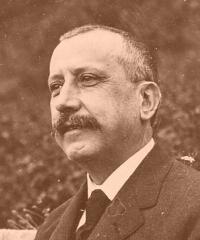
Joan Rubió y Bellver was a Spanish architect famous for his contributions to the Catalan Modernista movement.

La Verneda i la Pau is the northernmost neighborhood of the Sant Martí district of Barcelona, Catalonia (Spain). It borders the neighboring municipality of Sant Adrià de Besòs.

Alicia Sánchez-Camacho Pérez is a Spanish lawyer and politician. She served as the President of the People's Party in Catalonia from 2008 to 2017.

Public transport in Badalona consists of a variety of services operated by several companies, most of them associated with Autoritat del Transport Metropolità, the main transport authority of the Metropolitan Area of Barcelona. At just over 220,000 inhabitants, Badalona is one of Catalonia's most populated towns, and is located immediately next to the capital Barcelona, along the Mediterranean Sea coastline. It is both a dormitory town and a developed city in itself, which makes the proper articulation of transport of vital importance.
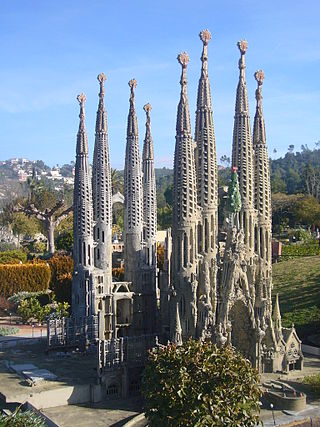
Catalunya en Miniatura is a miniature park inaugurated in 1983 in Torrelles de Llobregat, 17 km (11 mi) from Barcelona. The park is 60,000 m2 (650,000 sq ft), 35,000 m2 (380,000 sq ft) of them devoted to the scale models, it is one of the largest miniature parks in the world, and the largest of the 14 miniature building exhibitions present in Europe. It displays 147 models of palaces, churches, bridges and other buildings from Catalonia and Mallorca and it includes all the major works by the renowned architect Antoni Gaudí.
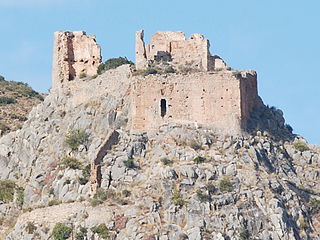
Borriol is a town and municipality located in the province of Castellón, Valencian Community, Spain.

Óscar Horta Álvarez is a Spanish animal activist and moral philosopher who is a professor in the Department of Philosophy and Anthropology at the University of Santiago de Compostela (USC) and one of the co-founders of the organization Animal Ethics. He is known for his work in animal ethics, especially around the problem of wild animal suffering. He has also worked on the concept of speciesism and on the clarification of the arguments for the moral consideration of nonhuman animals. In 2022, Horta published his first book in English, Making a Stand for Animals.
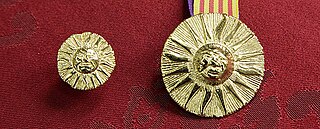
The Ramon Llull Award is an honor awarded annually by the Government of the Balearic Islands to persons or entities of the Balearic Islands that have excelled in any field. It was established in 1997 by Decree 3/2014.